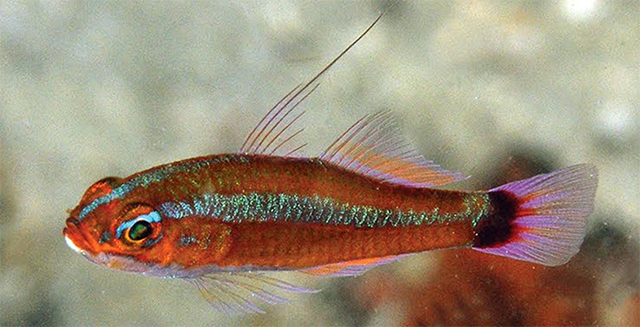| Gobiidae (Gobies), subfamily: Gobiinae |
| 2.69 cm SL (male/unsexed) |
|
reef-associated; marine; depth range - 3 m |
| Indo-Pacific: from Ryukyu Islands, Japan to the Solomon Islands, south-west west to Rowley Shoals, Western Australia; no record yet from Palau, but present in the Philippines; appears to extend at least to Maldive Islands from underwater photos. |
|
Dorsal spines (total): 7-7; Dorsal soft rays (total): 8-8; Anal spines: 1-1; Anal soft rays: 8-8. This species is distinguished by the following characters: a bony interorbital 73-100% pupil diameter; fully scaled nape with the anterior rows ctenoid in adults; second dorsal spine that may reach posteriorly as far as the anterior dorsal procurrent caudal fin rays in mature males, usually reaches to at least the middle of the second dorsal fin; often unbranched pectoral-fin rays; the unbranched fifth pelvic-fin ray is about 50% the length of the fourth ray; posterior caudal peduncle with a large dark blotch; fresh and mature specimens >1.8 cm SL usually with a blue stripe along the lateral midline of the body passing across the dorsal margin of the pupil, another blue stripe in the dorsal midline, a third beneath the eye across the upper cheek, and blue blotches just anterior to the eye, on the opercle, and the posteroventral side of the iris; the base of the caudal fin posterior to the caudal spot is suffused with magenta with diffuse tapering reddish streaks; preserved specimens with a dark brown dorsal surface of the snout which is darker (often black) in the midline, with scattered, larger and much darker melanophores, between the front of the eye and the middle of the upper jaw is a dark diffuse blotch, the cheek below the eye has a diffuse stripe of brown chromatophores that passes along the ventral edge of the orbit dorsally, and the brown spot on the chin just behind the symphysis of the lower jaw is usually absent (Ref. 109919). |
|
|
Least Concern (LC); Date assessed: 07 September 2021 Ref. (130435)
|
| harmless |
Source and more info: www.fishbase.org. For personal, classroom, and other internal use only. Not for publication.
